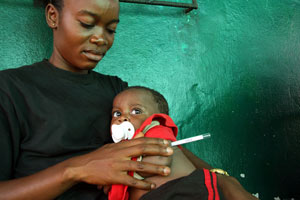A case study on the Tellewoyan Memorial Hospital -a referral hospital in Lofa County, Liberia run by the Government of Liberia with World Bank Funding.
With 1,072 maternal deaths for every 100,000 births, Liberia has one of the highest maternal mortality ratios in the world. The World Health Organization defines maternal mortality ratio as the number of pregnant women who die per 100,000 live births. Maternal mortality ratio is one of the major criteria used to evaluate the quality of medical care in a country. With a figure like that, it is needless to say how far behind we are lagging as a nation in terms of healthcare.
Lofa County, Liberia’s 4th most populous county with approximately 340,818 inhabitants, is home to only 4 hospitals; 2 of which are private and the other 2 are operated by the Government of Liberia (GoL). Tellewoyan Memorial Hospital is the county referral hospital and as such, one would expect it to be the best equipped of the 4 facilities.
Tellewoyan Memorial Hospital is however faced with many constraints. Taking into consideration the GoL policy of free healthcare, all services and drugs are to be rendered to the patients free of charge. This is however extremely difficult, mainly due to the inconsistent provision of allotment from the GoL to the facility. The facility has many constraints in providing adequate healthcare to its patients which can be considered in terms of lack of electricity, lack of medical supplies and equipment, and inadequate supply of drugs.
The Hospital has three generators at her disposal, with two of them having capacities of 150 KVA each. The 150 KVA generators have enough power to supply the entire facility as well as the senior and junior staff quarters. These two generators consume approximately 3 gallons of diesel per hour. The third generator has a capacity 75 KVA which can produce enough power to supply everything with the exception of the autoclave, an equipment used for sterilization of materials for surgeries. This generator consumes approximately 2 gallons of diesel per hour. Considering these are barely sustainable in this current economy, a solar panel system was set up in the Medical Laboratory which provides it with electricity to run lab tests, as well as charge the batteries used to provide minimal amount of light to the various wards at night.
However, there is no such luxury available for the operating room and as such, if a patient requires surgical intervention, that patient and their relatives have to provide between 2 to 4 gallons of diesel in order to put the generator on to carry out the procedure.
Another reason for electricity being vital to patient care at Tellewoyan is because since there is almost always no oxygen available in the oxygen tanks (they have to be refilled in Monrovia); the oxygen concentrator machine is used to generate oxygen from regular tap water. This process however requires a constant supply of electrical power in order for this machine to work.
In July this year, a woman who had recently delivered, was diagnosed with Peripartum Cardiomyopathy (heart failure due to her pregnancy). Her condition was so critical that she needed to have a constant supply of oxygen. This was not possible because there was no oxygen in the facility and there was no fuel to use the oxygen concentrator. The family then had to provide gasoline for a small generator in order to provide the oxygen the patient needed. Few hours later, the patient started gasping for air when the generator ran out of gasoline, and the family was yet to get additional gasoline for the generator. Sadly, the patient passed away a few minutes later. This is an account of just one of many similar cases that have occurred, and several more that could occur if nothing substantial is done.
With the recent Ebola Viral Disease (EVD) still fresh in memory and the current Lassa Fever outbreak in the country, health workers need to be more vigilant than ever in preventing the transmission of such infectious diseases. This is however only possible when those materials needed are made available. The facility itself does not have them available due to “lack of funding” so patients, be it an emergency situation or not, have to purchase gloves, band aid, syringes and every other thing needed for their care, from nearby drug stores in order to get the care they need.
For more than 6 months, the X-Ray machine has been down, so when patients come with a condition that requires having an X-Ray done, they either have to take the 1-hour journey to Macenta in Guinea or depending on the road condition, the 5-7 hours’ journey to Phebe Hospital in Bong County, because none of the 4 hospitals in Lofa County have a functional X-Ray machine.
Take a visit to the medical laboratory at the hospital and you would be surprised to know that the only services they can currently supply are a malaria test and a urine analysis. Before a patient can have his or her hemoglobin (blood level) done, he/she has to purchase the hematocrit tube used to collect the blood. These shortcomings at the medical laboratory are not due to lack of equipment or staff (because all the necessary equipment are available), but there are either no reagents (substances used to produce chemical reactions that allow researchers or laboratory technicians to detect, measure, produce, or change other substances) to use or no supplies for the other tests.
The pharmacy at Tellewoyan Memorial Hospital is ill-equipped to provide the medications needed for the cases encountered. There are many essential drugs needed that are not available. A common example is when three babies died during the month of September because they needed the drug Phenobarbital to stop them from having seizures. This medication is not available in Lofa county so the relatives had to order it from Monrovia; sadly none of the babies were able to survive until the medication arrived. Some other medications that are available in limited quantities have a different problem of storage. The heat in the pharmacy has already started causing some of the drugs to change color while the potency of other medications, like insulin for diabetes and oxytocin for delivery, are questionable because they cannot be stored in the refrigerator due to lack of electricity.
Amidst all these constraints, it is difficult to see how much impact health workers could even have, because they basically have nothing to work with.
Authored by Anonymous

